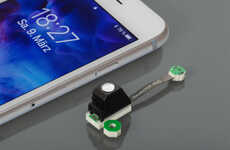
NASA Creates a Chemical-Sensing iPhone Application
Marissa Liu — November 13, 2009 — Tech
References: nasa.gov
Jing Li, a scientist at NASA has developed a chemical sensor application for the iPhone. Working within the Department of Homeland Security's Science and Technology Directorate's Cell-All program Li created a stamp-sized device that can attach to an iPhone and detects chemicals.
So far the iPhone chemical sensor application has sniffed out small amounts of chemicals like methane, ammonia, and chlorine gas. The device is cheap and doesn't require a lot of power. Once the detection data is confirmed the phone can send the information on via Wi-Fi.
So far the iPhone chemical sensor application has sniffed out small amounts of chemicals like methane, ammonia, and chlorine gas. The device is cheap and doesn't require a lot of power. Once the detection data is confirmed the phone can send the information on via Wi-Fi.
Trend Themes
1. Chemical Sensing Applications - Opportunity for developing smartphone applications with chemical-sensing capabilities for various industries and purposes.
2. Miniaturized Chemical Sensors - Potential for creating compact, low-power chemical sensors that can be easily integrated with mobile devices and IoT technology.
3. Wireless Data Transmission - Potential for advancing wireless data transmission technologies to enable real-time chemical detection and analysis via smartphones.
Industry Implications
1. Environmental Monitoring - Disruptive innovation opportunity to enhance air quality monitoring and pollution control through smartphone chemical sensors.
2. Public Safety and Security - Opportunity to revolutionize threat detection and emergency response systems by leveraging chemical-sensing capabilities of smartphones.
3. Industrial Chemical Detection - Disruptive innovation opportunity to streamline industrial operations and ensure workplace safety through smartphone-based chemical detection.
0.3
Score
Popularity
Activity
Freshness























